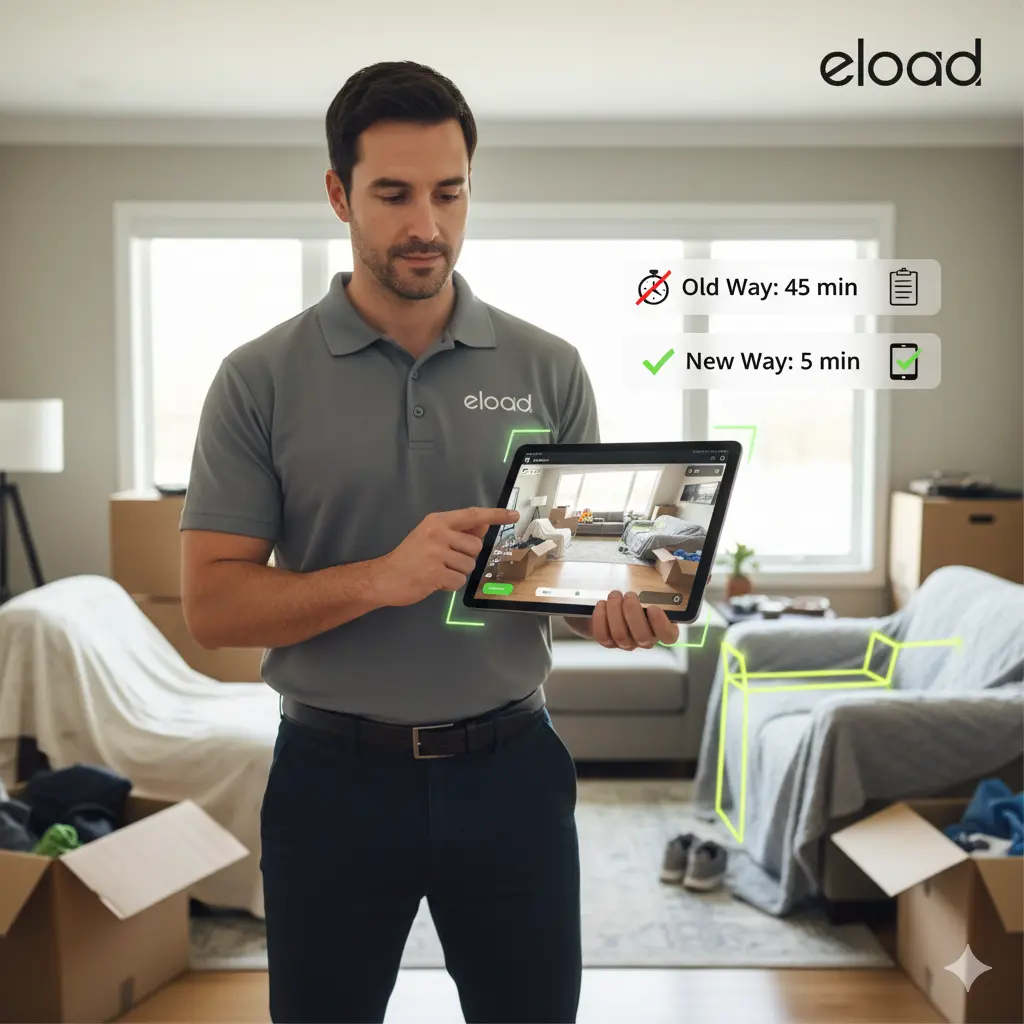Overview
A mid-sized mover in the GCC struggled with slow onsite estimates, unpredictable quotes, and wasted crew time. After a short pilot with Eload, they transformed their estimate workflow: customers scanned rooms from home, operations received dispatch-ready job cards, and crews arrived prepared — cutting estimate friction and improving day-to-day utilisation.
The problem
- Onsite estimates drained staff time and limited daily capacity.
- Many quotes were inaccurate or incomplete, causing follow-up visits.
- Poor load planning left trucks underutilized and raised per-job costs.
- Customer disputes over scope or pricing created service overhead.
Why they chose Eload
The company wanted to reduce time spent per estimate without sacrificing accuracy. They needed a solution that:
- Produced itemized quotes remotely,
- Generated actionable job cards for dispatch, and
- Integrated with existing CRM/dispatch systems.
Eload matched those needs: camera-based scans → AI estimation → load optimization → dispatch-ready output.
Implementation (how we rolled it out)
- Demo & alignment (Week 0): Short walkthrough with ops and sales teams to map current estimate flow.
- 30-day pilot (Week 1–4): Live pilot on selected routes — customers invited to scan during lead capture. Pilot scope: remote quoting + job card delivery. (Pilot length and scope agreed with partner.)
- Integration & training (Week 3–5): Quick API/webhook setup to push job cards into the mover’s dispatch system; two 60-minute training sessions for estimators and dispatchers.
- Scale (Month 2+): Expand pilot learnings across the fleet and add white-label partner portal for sales staff.
How Eload worked in their workflow
- Customer receives a link or opens the app and scans key rooms with phone camera.
- Eload’s AI estimates dimensions, volume, and packing needs and generates an itemized quote.
- The system creates a dispatch-ready job card (measurements, photos, packing instructions, load plan) and pushes it to dispatch via webhook.
- Dispatch assigns crew; the crew receives a clear packing plan and timeline — minimizing on-site surprises.
Results & impact
- Fewer onsite visits: Most initial house calls were eliminated; many estimates were completed remotely, saving travel time and staff hours.
- Faster quoting: What once took 30–60 minutes for an onsite estimate became an instant, itemized quote via scan.
- Improved dispatch accuracy: Crews arrived with exact specs and photos, reducing rework and disputes.
- Operational speed: Pilot partners reported faster move execution in follow-up measures (pilot result).
- Pilot scale: The technology was validated in live rollouts across multiple routes during early pilots (pilot result).
“Eload turned guesswork into a job card. Our crews arrive prepared and we spend less time chasing measurements.” — Ops lead, pilot partner (anonymized)
(All outcome claims above are from the partner pilot and labeled accordingly.)
The ROI playbook — how you can replicate it
- Pick a low-risk pilot cohort: Start with local, residential moves on non-peak days.
- Train a small team: 1–2 dispatchers + 2 estimators can run the pilot and collect feedback.
- Use the app for lead capture: Offer remote scanning as a default option when customers request quotes.
- Integrate job cards into dispatch: Use Eload webhooks or CSV exports to ensure job cards populate your dispatch system.
- Measure baseline KPIs: Track estimate time per job, quote→book conversion, and truck fill rate before and after.
- Iterate & scale: Tweak scan guidance, add targeted training, then roll out to more routes.
Lessons learned (practical takeaways)
- Clear scan guidance (how to angle the phone, light the room) improves first-pass accuracy.
- Flagging specialty items early reduces day-of surprises.
- Small integrations (webhooks) deliver large operational wins by removing manual data entry.
- Communicate the new process to customers to increase scan adoption and reduce no-shows.
How Eload supports long-term adoption
- White-label partner portals let you offer remote quoting under your brand.
- APIs & webhooks integrate job cards into existing dispatch and CRM systems.
- Onboarding & SLA packages ensure your team is trained and supported during rollout.
- Load optimization helps you convert saved estimate time into higher truck utilization.

